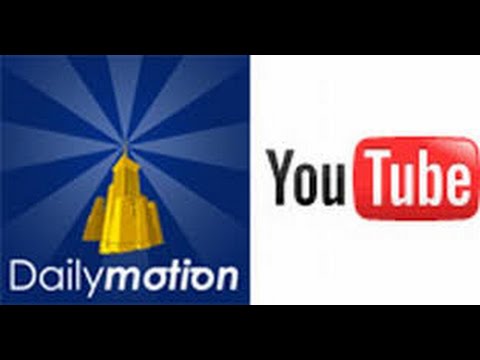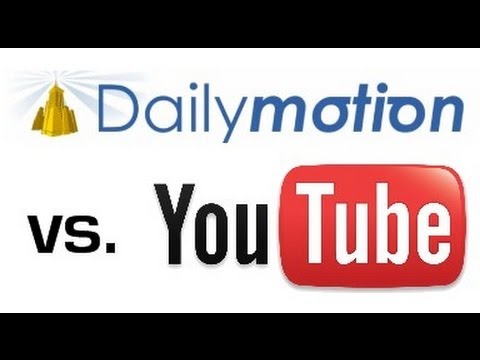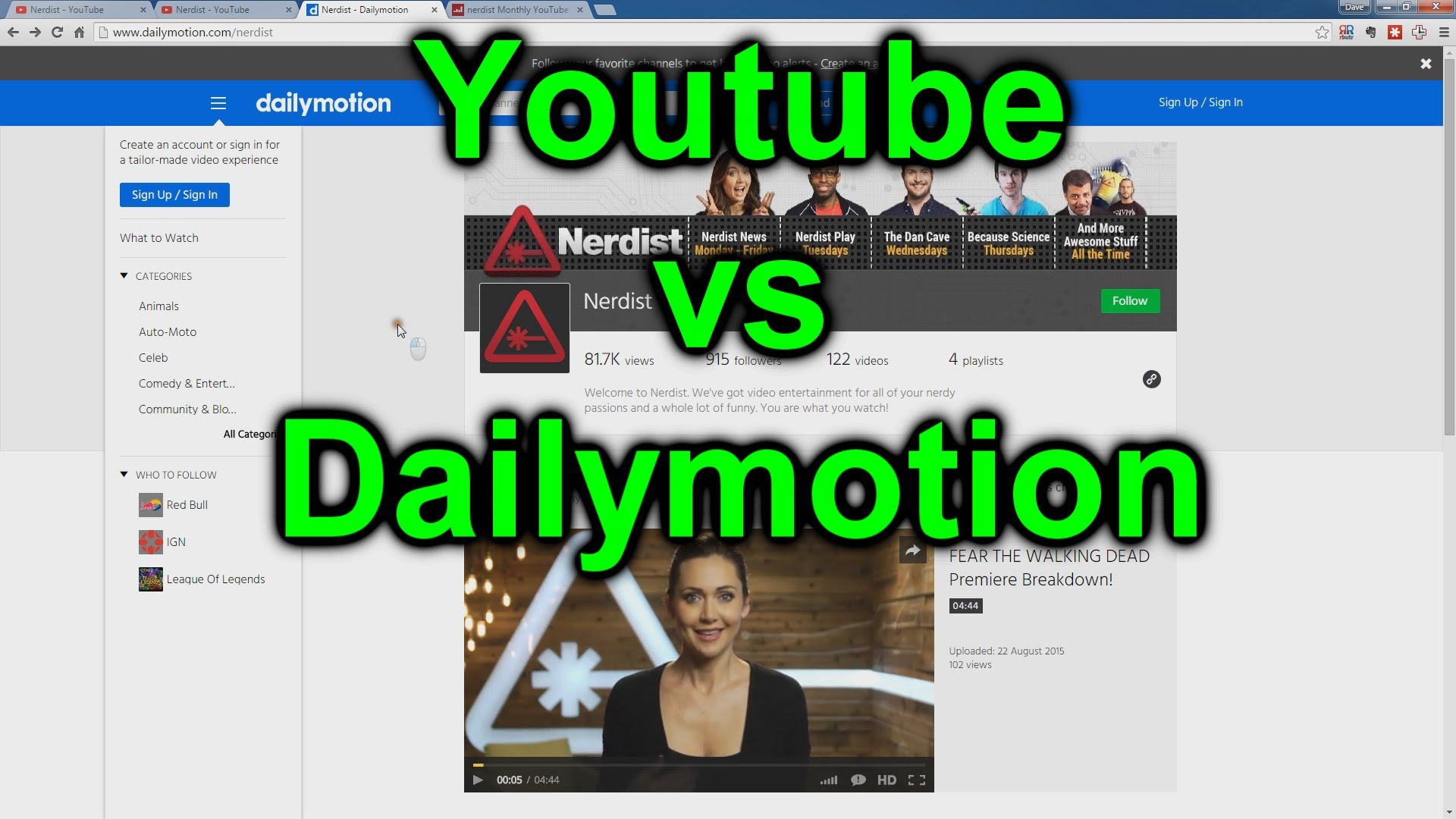Video-sharing platforms have transformed the way we consume and share content. With just a click, users can access a vast sea of videos ranging from entertaining clips to educational tutorials. The two most notable players in this on-demand video landscape are Dailymotion and YouTube. Each platform has unique features, communities, and advantages that cater to different audiences. In this post, we’ll dive into what makes these platforms tick, starting with an overview of Dailymotion.
Overview of Dailymotion

Dailymotion, launched in 2005 and headquartered in France, is a video-sharing platform that offers a diverse array of user-generated content, ranging from amateur videos to high-quality productions. While it may not have the same colossal reach as YouTube, it still holds a significant place in the market, providing users with an alternative for discovering and sharing videos.
Key Features of Dailymotion
- Content Variety: Dailymotion hosts a wide range of categories, including news, sports, music, and entertainment. This diverse collection caters to many interests, making it a versatile choice for users.
- Video Quality: The platform supports high-definition video up to 4K, enabling content creators to share visually stunning works without compromising quality.
- User-Friendly Interface: Its interface is designed for easy navigation. Users can search for content, categorize videos, and manage their profiles effortlessly.
- Localization: Dailymotion focuses on local content, tailoring its offerings for various regions. This localization aspect makes it particularly appealing to users looking for culturally relevant videos.
For content creators, Dailymotion provides an excellent opportunity to reach global and local audiences. Creators can monetize their content through ads and partnerships, similar to YouTube, but with different terms and conditions. It's also known for being more accommodating to varied content types, making it friendly to indie filmmakers and lesser-known artists.
One standout aspect of Dailymotion is its community focus. It encourages user interaction through comments, sharing features, and content curation, fostering a sense of community among users who share similar interests. Dailymotion also strives to promote a safe environment, emphasizing content moderation better than many newer platforms.
However, Dailymotion does have its challenges in gaining traction against a behemoth like YouTube. It faces scrutiny regarding its discoverability features, which don’t match YouTube’s sophisticated recommendation system. Users may find it more challenging to stumble upon trending videos or discover new creators compared to the algorithmic prowess of YouTube.
In terms of user statistics, Dailymotion boasts around 250 million monthly unique users, which, while impressive, pales compared to YouTube’s billions. Nevertheless, being a niche platform, Dailymotion remains an underdog that appeals to those looking for an alternative video experience.
In summary, while Dailymotion may not overshadow YouTube in terms of sheer numbers, it offers unique features and a focused community. It’s a great option for those who wish to explore a variety of content and discover hidden gems in the world of video sharing.
Also Read This: How to Watch Dailymotion on Live TV: Stream Videos on Your Television
3. Overview of YouTube

YouTube is the heavyweight champion of video-sharing platforms, launched in 2005 and quickly becoming a household name. Acquired by Google in 2006, it has evolved into a powerful social media and information platform. With billions of users globally, YouTube offers a vast array of content that ranges from entertainment and education to tutorials and live streams.
One of the key features that set YouTube apart is its robust algorithm, which drives content discovery. This means that when you log in, the platform's AI curates a personalized feed for you based on your viewing habits. Whether you love music videos, DIY projects, or cat videos, YouTube is likely to have something that captures your interest.
In terms of monetization, YouTube provides various avenues for creators. The YouTube Partner Program allows content creators to earn money through ads, channel memberships, Super Chats, and merchandise. This has incentivized many individuals and brands to leverage the platform to build their presence and connect with audiences worldwide.
Another significant advantage of YouTube is its integration with Google's ecosystem. This means enhanced search capabilities and discoverability, allowing content to reach a wider audience. Creators can also benefit from YouTube Analytics, a powerful tool that provides insights into viewer engagement, demographics, and more, enabling them to refine their content strategies.
YouTube's community features also foster interaction, with options for comments, likes, and shares. Creators often develop a loyal fan base, making it a thriving environment for both small channels and major brands.
Also Read This: How to Watch Age Restricted Dailymotion Videos
4. User Demographics and Engagement

Understanding user demographics and engagement on YouTube is crucial for creators and marketers alike. Roughly over 2 billion logged-in users visit YouTube each month, and they come from all walks of life, reflecting a diverse audience. Here’s a quick breakdown of YouTube’s demographic landscape:
- Age: Users span across various age groups, with a significant number between 18 and 34 years old. However, its reach into older demographics is also notable, with many users over 35 actively engaging with content.
- Gender: There is a fairly even split between male and female users, with slight variations depending on the genre of content. For instance, gamers may skew more male, while beauty and fashion channels often attract a larger female audience.
- Global Reach: YouTube boasts a massive international presence, with more than 80 localized versions available in over 100 countries. This global accessibility allows diverse cultural content and niche markets to thrive.
When it comes to engagement, YouTube users are incredibly active. Over a billion hours of video content are watched each day, emphasizing the platform’s significant engagement levels. With features like likes, comments, and shares, users often interact closely with content, actively contributing to discussions and communities.
Furthermore, live streaming has seen a massive increase in popularity, with many creators using this feature to engage real-time with their audiences. This not only enhances viewer engagement but also fosters a sense of community as subscribers feel connected to their favorite creators.
In conclusion, YouTube stands out not just for its vast content library but also for its active, diverse user base. The platform's powerful tools for creators to engage with their audience further highlight its role as a leading figure in the video-sharing industry. Understanding these demographics is key for anyone looking to leverage the platform for growth, marketing, or simply to enjoy content in their preferred niche.
Also Read This: How Dailymotion Brings Learning and Fun Together for All Ages
5. Content Variety and Availability

When it comes to content variety, both Dailymotion and YouTube offer unique advantages and cater to different audience preferences. However, they do so in distinct ways that can significantly affect the user experience.
YouTube is renowned for its vast and diverse library. With millions of videos spanning countless genres, from vlogs and tutorials to music videos and documentaries, there’s something for everyone. This platform hosts a plethora of content, thanks to its massive user base that continuously uploads fresh material. If you’re in the mood for cooking, gaming, education, or entertainment, YouTube has you covered.
On the flip side, Dailymotion, while smaller in scale, showcases a curated approach to content. It offers a unique selection of videos, often focusing on independent creators and niche topics that might not get as much spotlight on YouTube. This can lead to discovering hidden gems that you won’t find in the mainstream.
Here’s a quick breakdown:
- YouTube:
- Extensive content library
- All genres covered extensively
- Some exclusives from major creators
- Dailymotion:
- Curation of unique and niche content
- Focus on independent and lesser-known creators
- Localized content in various languages
Another aspect to consider is availability. YouTube is available worldwide and translates content into multiple languages, making it a go-to platform for global audiences. Meanwhile, Dailymotion ensures localized content for specific countries, giving it an edge in certain markets. This means that if you're looking for content from a particular region or in a specific language, Dailymotion might be the better choice.
In summary, if you're looking for sheer volume and variety, YouTube is hard to beat. Meanwhile, if you’re interested in discovering independent creators or niche content that might not follow mainstream trends, Dailymotion could be a delightful surprise.
Also Read This: How to Wear Push-Up Bra on Dailymotion: Tips for Comfort and Support
6. Monetization Options for Creators
Turning a passion for video into a source of income is an appealing prospect for many creators, and both Dailymotion and YouTube offer monetization options—albeit with some key differences.
YouTube is famous for its Partner Program, which allows creators to monetize their videos through ads. Here’s a quick look at how it generally works:
- Creators need at least 1,000 subscribers and 4,000 watch hours within the past year to qualify for the program.
- Once accepted, creators can earn revenue from ads, Super Chats, channel memberships, and merchandise shelf.
- YouTube provides reliable metrics and analytics tools, allowing creators to understand their audience and optimize monetization strategies.
YouTube’s extensive algorithm often means that popular videos can generate significant income, especially if created by established channels. However, with great potential comes great competition. As many can attest, building a successful channel takes time, dedication, and often a bit of luck.
Now let’s talk about Dailymotion. It also has a monetization program, but the approach is slightly different:
- Dailymotion allows creators to earn money via ad revenue and subscription services.
- It offers a simpler threshold for monetization, making it accessible to a wider range of creators.
- The platform provides a unique revenue-sharing model, allowing creators to potentially earn more from fewer views compared to YouTube.
While Dailymotion might not rival YouTube in sheer number of monetization channels, it does offer opportunities for creators looking to find their niche audience without being overwhelmed by competition. The choice between the two may ultimately depend on your goals, content strategy, and the audience you wish to engage.
In conclusion, while YouTube offers robust monetization with diverse revenue streams, Dailymotion provides a more accessible pathway for those wanting to share content in a more niche environment. Each platform has its perks, so creators should consider their content style and audience when choosing where to focus their efforts.
Also Read This: Daria Clips and Availability on Dailymotion
7. Algorithm and Discovery Features
When it comes to finding content, algorithms play a crucial role on both Dailymotion and YouTube. Let’s take a closer look at how each platform approaches content discovery and what it means for users.
YouTube has a well-established algorithm that’s often praised for its effectiveness in keeping users engaged. It analyzes numerous factors, such as viewer watch history, preferences, and engagement metrics. Users are often presented with a personalized selection of videos tailored to their interests. This algorithm also highlights trending videos and popular channels, which can be a double-edged sword:
- Pros: Users discover content that they enjoy, leading to longer viewing times.
- Cons: Smaller creators might struggle to gain visibility since the algorithm often favors established channels with a substantial following.
In contrast, Dailymotion takes a slightly different approach by focusing on a more balanced spotlight for both mainstream and niche creators. While it also utilizes algorithms for recommendations, Dailymotion emphasizes recent uploads and trending content more prominently on its homepage. This method allows lesser-known creators to gain visibility more easily and attracts viewers who enjoy discovering new content rather than just the most popular videos.
Both platforms give users the option to search for specific content based on keywords or categories. However, YouTube's extensive tagging and indexing system makes it easier to find specific topics, while Dailymotion’s simpler interface might appeal to users who are looking for a more streamlined experience.
In summary, if you’re someone who loves personalized recommendations and sticking to popular trends, YouTube may be your go-to. However, if you’re more about exploring and discovering new content from a more diverse range of creators, Dailymotion has you covered.
Also Read This: How to Share a Dailymotion Video on Facebook for Maximum Visibility
8. Video Quality and Streaming Performance
Video quality and streaming performance are vital aspects of any video-sharing platform, as they directly impact user experience. Let’s explore how Dailymotion and YouTube compare in these areas.
YouTube sets a high standard when it comes to video quality. The platform supports a variety of resolutions, ranging all the way up to 8K UHD. Most creators upload content in high definition, ensuring that viewers can enjoy sharp images and clear sound. Moreover, YouTube’s adaptive bitrate streaming technology optimizes video playback based on the viewer's internet speed. This means that:
- On a fast connection: Users can stream videos in the highest available quality.
- On a slower connection: YouTube automatically adjusts the resolution to ensure smooth playback without buffering interruptions.
On the other hand, Dailymotion also provides good video quality, generally supporting resolutions up to 4K UHD. However, it may not have the same level of consistency found on YouTube. While many videos are available in HD, some content on Dailymotion might be of lower resolution, depending on how the uploader has chosen to format their videos.
Streaming performance on Dailymotion has improved over the years, but it can still experience hiccups, particularly during peak times when server traffic is high. Users have reported occasional buffering issues compared to YouTube, which has invested heavily in its infrastructure to minimize these interruptions.
Ultimately, if you're after the highest quality and seamless streaming experience, YouTube leads the pack. However, Dailymotion holds its own with decent quality and a focus on unique content from up-and-coming creators. No matter which platform you choose, both are striving to provide the best video experience for their audiences!
Also Read This: How the Heart Pumps Blood: Educational Content on Dailymotion
9. Community Guidelines and Content Regulation
When it comes to platforms like Dailymotion and YouTube, community guidelines and content regulation play a pivotal role in shaping the user experience. These rules dictate what can and cannot be shared, affecting everything from user trust to content diversity. Both platforms aim to foster safe environments, yet they each have their unique approach to enforcement and transparency.
YouTube is known for its comprehensive community guidelines. They cover a wide range of topics, including:
- Hate speech
- Harassment and bullying
- Child safety
- Copyright infringement
- Spam and deceptive practices
The enforcement on YouTube can be strict, and the system uses a combination of algorithmic tools and human moderators to review content. Creators often find their videos demonetized or removed if they violate these guidelines, which can lead to frustration and confusion. However, YouTube provides detailed explanations about the rules and offers avenues for appeal, which can help creators understand what went wrong.
On the other hand, Dailymotion follows its own set of community guidelines, which are somewhat less extensive than YouTube's. The major areas of focus include:
- Respecting intellectual property
- Content safety and legality
- Protection of minors
- Prohibition of spam
Dailymotion takes a more lenient approach compared to YouTube, and while it also employs content moderation teams, the platform is often viewed as more accommodating for independent creators. That said, moderation might not be as rigorous, which could result in a wider variance in content quality.
In summary, both Dailymotion and YouTube strive for a safe user environment but differ in their enforcement strength and transparency levels. YouTube’s extensive guidelines can limit creative freedom at times, while Dailymotion's flexibility may allow for more diverse content, albeit with its own risks regarding moderation.
Also Read This: Accessing the Old Dailymotion Layout with Easy Instructions
10. International Presence and Localization
Understanding the international presence and localization efforts of Dailymotion and YouTube is crucial if you're looking to reach a global audience. Both platforms have made substantial strides in catering to diverse languages and cultures, but the scope and effectiveness of their strategies differ.
YouTube has a dominant international presence, operating in over 100 countries and supporting 80+ languages. This enables them to tailor the viewing experience according to the cultural and language preferences of its users. YouTube’s ability to adapt content for various regions has been a key factor in its global success. Here are some highlights:
- Customized content recommendations based on geographical trends
- Localized advertisements that resonate with specific audiences
- Content creators from different countries gaining prominence within their local markets
Dailymotion, while also international, has a more concentrated presence, particularly in Europe and parts of North Africa. It’s known for supporting a variety of languages, but its localization efforts aren't as far-reaching as YouTube's. Areas of focus for Dailymotion include:
- Curating content that reflects local cultures
- Partnering with regional creators for more authentic content
- Localized marketing strategies to engage specific audiences
Though both platforms strive for global reach, YouTube's larger user base and broader localization strategies give it an edge in terms of international engagement. Whether you’re a content creator or a viewer, understanding these aspects can help you make informed choices about where to publish or consume video content.
Conclusion: Dailymotion's Position in the Market
In the ever-evolving landscape of online video platforms, Dailymotion holds a unique position that caters to specific user needs and preferences. Unlike its more prominent competitor, YouTube, Dailymotion focuses on providing a curated experience for users who appreciate a different flavor of content. Here are some key aspects of Dailymotion's standing in the market:
- Content Diversity: Dailymotion hosts a variety of content categories, including music, news, and sports, drawing in niche audiences.
- User-Friendly Interface: The platform offers a clean and straightforward user interface, making it easy for viewers to navigate and discover new content.
- Monetization Options: Dailymotion provides flexible monetization options for creators, allowing them to earn revenue through ads and partnerships.
- Global Reach: With a focus on international markets, Dailymotion appeals to users and creators from various regions, expanding its global footprint.
Although it doesn’t rival YouTube in terms of sheer volume or popularity, Dailymotion successfully carves out its niche by emphasizing quality over quantity. The platform is often favored by smaller creators looking to connect with an audience that values originality and less mainstream content.
In conclusion, while Dailymotion may not challenge YouTube’s dominance head-to-head, its distinctive approach towards curation and international content positions it as a valuable alternative in the online video market.
 admin
admin








